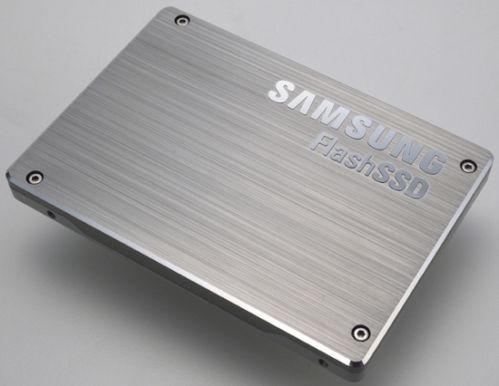Samsung: SSD Match HDD Prices in a Few Years
Admit it, you want a solid state drive. The only thing stopping you is the price, which is understandable -- but Samsung says that won’t be a concern within a few years.
Gig for gig, nothing touches the old spinning magnetic-based storage for its value. While we may all want the performance and reliability benefits from solid state storage, the price differential makes it seem like an impractical choice.
It won’t be that way forever, says Samsung. We’re well aware the computing technology gets more affordable over time, but Samsung -- who makes both spinning hard disk drives and flash memory -- says SSDs will be on par explains why prices are where they are right now, though prices will drop continue to at a steady pace.
"Flash memory in the last five years has come down 40, 50, 60 percent per year," said Brian Beard, flash marketing manager for Samsung Semiconductor, in an interview with ZDNet. "Flash on a dollar-per-gigabyte basis will reach price parity, at some point, with hard disk drives in the next few years."
"The difference in cost is fundamentally very different. A hard drive has a fixed cost of $40 or $50 for the spindle, the motors, the PCB (printed circuit board), the cables," he told the website. "To make the hard drive spin faster (increase speed) or to add capacity doesn't really add a lot of incremental cost to the drive."
"When you contrast this with SSDs, they also have a fixed cost for the PCB and the case and the controller, which is lower than the fixed cost of a hard drive," according to Beard. "But as you scale the capacity of the SSD up, the cost scales linearly. For example, if the spot price of the flash chip itself is $2, a 64GB drive is going to cost $128 just for the flash and then you would add the fixed cost of the PCB and the case.”
The sad reality here is that it will take quite a while for flash memory density and prices to catch up to current hard disk drive costs. On top of that is flash memory price’s volatility, which might not be so painful when buying 4 GB of RAM, but will really add up when buying a 256 GB SSD.
Get Tom's Hardware's best news and in-depth reviews, straight to your inbox.
There will come a time when data storage will move to solid state, but in the interim we expect to see a transition where the operating system and program files will be stored on a fast SSD, while a more economical HDD will be in the system for storage of data where speed is not a necessity, such as photos, videos and music.
-
skine So judging by the lowest priced 250-256 GB SSD ($489) and highest priced 250 GB HDD ($85) on NewEgg, and about 50% decrease in price per year, it looks like about three more years of hearing about how awesome SSDs are before I can actually buy one.Reply
On the other hand, I could have bought a 64 GB SSD for the same price as my 1.5 TB HDD. Again, assuming double the capacity for the same price for each year that passes, this would lead to about 4-5 years of waiting. -
Tindytim jacobdrjKind of redundant. Why bother stating this?They're saying that, the minimum price of a HDD is higher than that of a SSD because of the basic parts that must go into them. As the price on the memory itself goes down, the SSD will be cheaper, even if the memory itself still costs more.Reply -
snotling TindytimThey're saying that, the minimum price of a HDD is higher than that of a SSD because of the basic parts that must go into them. As the price on the memory itself goes down, the SSD will be cheaper, even if the memory itself still costs more.and for once it comes from an actual manufacturer who produces both types of storageReply
(Toshiba is the only other one doing both that I know of but who takes them seriously?)
so they do know at which pace the transition is currently going to solid state. to me this is more valuable than thousands of analyst predictions or speculations from other company who only produce either of the two.
Samsung is, after all, the new Sony. -
I think SSD's will drop in price as soon as they switch over to 6MB, 8MB, and then perhaps 12MB, 16MB, 24MB, and 32MB per flash chip.Reply
Just like RAM, an SSD is cheaper when supplied with 16 or 32MB chip blocks,compared to 4-8Mb per chip.
A better controller will not cost substantially more,and providing a SSD with 128MB of RAM will not add that much to the cost neither. -
hellwig I don't quite understand whats holding back flash memory. It's made leaps and bounds in the last couple years, but its been around so much longer. Compact Flash (with its built-in ATA controller) came out 15 years ago, but we're just now seeing practical applications for flash as a hard drive?Reply -
mmm123abc SSDs will replace HDs for computer vendors as soon as the price drops below hard drives for a drive that has enough capacity for the OS. If a drive falls below $40 for 80-100GB or so they will be standard.Reply
This will cause havoc in the HD business since the volume will dry up. Yes all the add on drives will probably be HD since $400+/TB is steep, but they will lose more than half their shipping volume.
I can see eventually an SSD integrated into motherboards for really low cost computers. A $35 or less chip(well probably chip set) on the MB would save the cost of a drive case, and a controller could probably be integrated into a southbridge...

